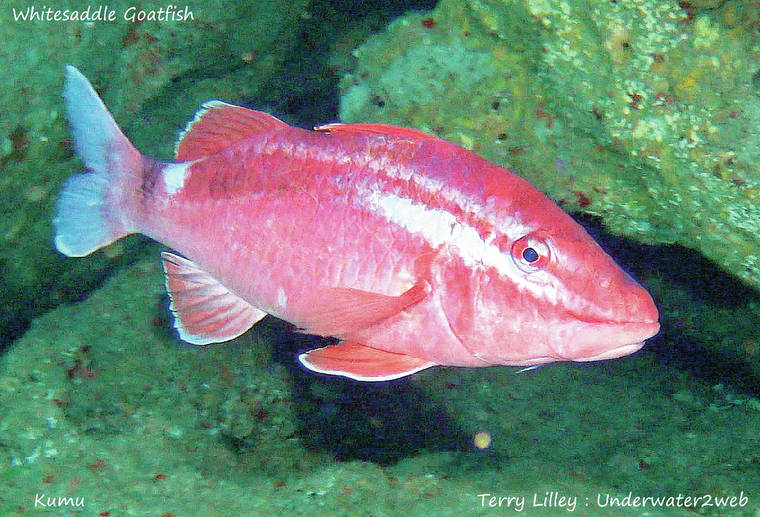Kumu is Hawai‘i’s only endemic shallow-water goat fish. It occurs no where else in the world other then here in Hawai‘i, and it was once one of the most common fish on the reef. You often see the word “kumu” used in the Hawaiian language, like “kumu hula” or “master teacher in the art of hula”
Kumu is Hawai‘i’s only endemic shallow-water goat fish. It occurs no where else in the world other then here in Hawai‘i, and it was once one of the most common fish on the reef. You often see the word “kumu” used in the Hawaiian language, like “kumu hula” or “master teacher in the art of hula”
This special fish is in the goat fish family, and has two barbels that resemble the goat’s beard. They use these barbels as little electromagnetic sensors that probe the sandy bottom to find hidden shrimp, crabs or small fish. Kumu is very good at finding small creatures hiding in the sand. and this may have lead to their decline in numbers. Kumu is such a master at finding the hidden food that other fish follow it around and try to steal the meal as soon as kumu scares it up from its sandy home. It is really fun to watch kumu hunting with two papio (jacks) on each side just waiting to steal its hard-earned meal.
Back in the 1950s the state imported the blue-stripe snapper (ta‘ape) from Marquesas Islands into Hawaiian waters, and this schooling fish exploded in numbers.
Today, over a third of the fish on the reef are ta‘ape, and they can have over 500 fish in one large school.
Now when the kumu is out feeding, hundreds of ta‘ape are in the area to steal its meal versus one or two papio in the past. The ta‘ape realized quickly that the kumu is a master at finding dinner, and they have taken advantage of this and have almost wiped out this colorful, native Hawaiian species.
Kumu are good to eat, and were one of the Hawaiians’ favorite food fish, but now they are quite rare and tend to live in caves where they feed at night.
Their bright-red color is actually black when they are in a cave because the red wavelength of light does not make it into the cave, so kumu are actually black, and are hard to see, so they can hide from the sharks, monk seals and large predator fish that might eat them.
You can see kumu in action in the movie “The World’s Guide to Hawaiian Reef Fish” at underwater2web.com.
•••
Terry Lilley, a marine biologist and lives in Hanalei. His websites include underwater-2web.com and www.gofundme.com/5urrm4zw.

Subscribe today for unlimited access.
Already a subscriber?
Login
Not ready to subscribe?
Register for limited access.
If you have a print subscription but require digital access,
activate your account.




